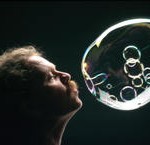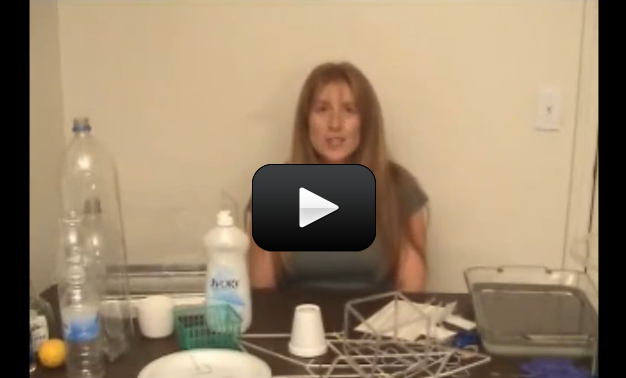
If you’re fascinated by the simple complexity of the standard soap bubble, then this is the lab for you. You can easily transform these ideas into a block-party Bubble Festival, or just have extra fun in the nightly bathtub. Either way, your kids will not only learn about the science of water, molecules, and surface tension, they’ll also leave this lab cleaner than they started (which is highly unusually for science experiments!)
Soap also makes water stretchy. If you’ve ever tried making bubbles with your mouth just using spit, you know that you can’t get the larger, fist-sized spit bubbles to form completely and detach to float away in the air. Spit is 94% water, and water by itself has too much surface tension, too many forces holding the molecules together. When you add soap to it, they relax a bit and stretch out. Soap makes water stretch and form into a bubble.
Please login or register to read the rest of this content.


Yes you can! Sorry about the quality of the video – this was one of my very first videos over ten years ago, when videos were much harder to make! I’ll put this on my re-shoot list for the future.
Hello! That was really cool. The video was pretty blurry most of the time, but I could still see how cool it was. If I wear gloves and use normal bubble soap from a store… can I still bounce it?
The answers to this should be in the video – I’ll check it over again and post anything that is missing.
I like the experiment but I feel I’m not finding some part of the lesson. For example, the doc mentions, “How did the soap-powered boat work? ” It also makes a few references to more explanations, like, “Describe the two ends of the snake-like soap molecule. How do these ends work to get things clean?”
I’d love to find this part of the bubble lesson.
Hi Grace! I am not sure what’s going on. It’s a little hard to imagine without a picture, but I think what’s going on is something like this: when you pierce a bubble with a soapy object (like a finger), you aren’t tearing it the way you are with a dry object so it doesn’t pop. Does that sound like what’s going on?
I did this experiment with my little brother (7yrs). We took a wire and bent it into a circle shape to make bubbles. When we dipped the bent wire into the solution, a ‘thin layer of the solution’ appeared inside the circle. Then, we dropped a small piece of lemon (about a inch wide) into the circle. The ‘thin layer of the solution’ stayed there! Why didn’t it ‘pop’ (disappear)? When we dropped a bigger piece of lemon, and it ‘popped’! Did it ‘pop’ because it was a bigger piece of lemon? We also tried bending the wire while the ‘solution’ was inside the circle, but it didn’t ‘pop’ either. Why?
Thanks!
-Grace (& Theodore)
::) it looks so cool,
CONRAD
This looks fun! I’m going to try it!
Distilled water leaves out the heavier minerals that cause bubbles to pop. Make sure your water is COLD so it doesn’t have all the tiny bubbles frothing up, which also destroys the film on large bubbles. I like your pipe cleaner idea! Thanks for sharing!
Many recipes for bubble juice call for distilled water. It does make a difference. Why is that????? Another tip. Pipe cleaners make awesome wands. The solution really sticks to the pipe cleaner ring and is especially good for younger bubble makers. Also, coat hangers make huge bubbles too. You can get 4 and 5 ft bubbles from hangers.
We made the giant bubble wand out of the yardsticks and it worked great.
Our family just went to the Bubblefest at the Discovery Science Center in Santa Ana and when we came home we wanted to know more about bubbles so I looked it up on your site. I found the bubbles experiment page so we did the activities and it was a hit! It was really neat to see how the ‘bubble man’ at the show might have been able to some of the things he did. The kids loved blowing bubbles from the strawberry baskets and from the loop of string that had two straws as handles.
My question is why should we only use Ivory dish soap or the green Dawn?
Also, what is the purpose of the glycerin/corn syrup/ lemon juice/…?
We actually might do an experiment about it….
Our family just went to the Bubblefest at the Discovery Science Center in Santa Ana and when we came home we wanted to know more about bubbles so I looked it up on your site. I found the bubbles experiment page so we did the activities and it was a hit! It was really neat to see how the ‘bubble man’ at the show might have been able to some of the things he did. The kids loved blowing bubbles from the strawberry baskets and from the loop of string that had two straws as handles.
My question is why should we only use Ivory dish soap or the green Dawn?
Also, what is the purpose of the glycerin/corn syrup/ lemon juice/…?
We actually might do an experiment about it….
Thank you,
Farhaana
Water has a lot of surface tension, which is why it rolls into a droplet the shape of a ball. You can see this effect when you overfill a cup before it overflows – you’ll get a bulge of water on top (the water line will be above the top of the cup). You’ll notice on a sweater that if you drip water onto it, it will often stay attached to the outside of the sweater and not soak through, just stick to it. When you add laundry soap, it makes the water more stretchy so it collapses and soaks into the material. Try the experiments on this page and you’ll see water surface tension in action!
I’m wondering why water droplets form and stick to the washing line after rain. I think that our washing line is made from nylon. I’ve also noticed that droplets stay on leaves after rain, too. Are these related? And why does the water “stick” and form bubble shaped droplets?
Ms.Aurora, My pawpaw and I did an experiment together. With Peper and Salt, the salt was white peaple and the peper was black peaple. You put salt and peper into a bowl of water and you put just alittle dabe of liquid soap on your finger and you put you finger in the corner of the bowl. And the results you should have is that, the peper and salt should scoot to the other side of the bowl. Its a really cool trick that I learned from him, and everyday I do that one and someother tricks that I have learned.
Yes – you can use all kinds of things instead of glycerin… like honey, maple syrup, corn syrup, lemon juice, sugar, etc. Which ones makes the best bubbles?
Hi Aurora,
Jessy and Robbie from New York were wondering about the use of the corn syrup in the bubble solution. We were wondering if this is a substitute for the glycerin.